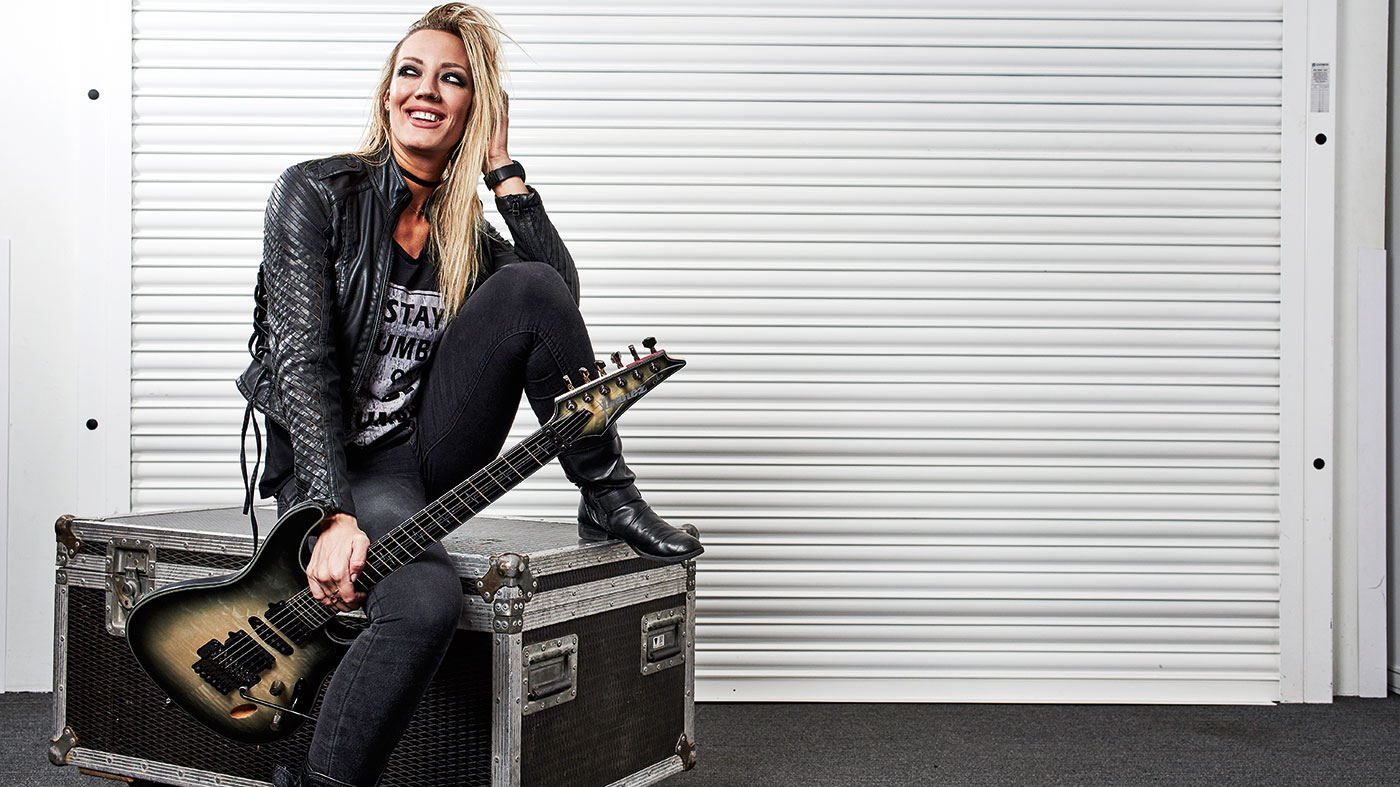Nita Strauss: “To be the first female Ibanez signature artist - that’s what I’ve dreamed of since the very beginning”
We talk to the trailblazing, 'board-shredding guitarist

Nita Strauss is the very definition of a guitar hero in the modern age. In 2018, she joined the likes of Steve Vai and Joe Satriani in having her own signature Ibanez model - an achievement that made her the first female musician ever in its history to have done so.
Similar things can be said about the Pandemonium DiMarzio pickups that come fitted on her JIVA axe, a feat she also holds close to her heart having idolised many of the company’s virtuoso endorsees. None of this would have happened if it were not for her dizzying technique and hard work ethic - which led to her stint as ‘Mega Murray’ in LA tribute act The Iron Maidens and being recommended to back Jermaine Jackson by one of Michael Jackson’s engineers.
The same individual had also encouraged her to audition for The King Of Pop’s ill-fated This Is It tour - a position that went to Orianthi - who, coincidentally, Strauss ended up replacing in Alice Cooper’s band during the summer of 2014.
Here, the player nicknamed ‘Hurricane’ Nita talks us through her six-string revolution and the fiery fretwork at play on her new solo debut, Controlled Chaos…
Killer queen
I grew up listening to classical music in the house; our dad instilled that into us - the importance of being aware of that lineage
Why being the face of change will always be one of Nita’s proudest accomplishments…
“I will never tire of hearing the words ‘first female Ibanez artist’. Because I try to stay away from the whole gender thing - male versus female, girl versus guy, what’s the difference, etc. I try to be the greatest guitar player I can be. But to be the first female signature artist and see my name up there with Vai, Satriani and Gilbert - that’s what I’ve dreamed of since the very beginning. And the same goes for my signature DiMarzio pickups. I hope I’m the first female of many… but I’m glad I was first!”
Baroque ’n’ roll
The guitarist on discovering how her classical roots and heavy metal weren’t all that different…
Get the MusicRadar Newsletter
Want all the hottest music and gear news, reviews, deals, features and more, direct to your inbox? Sign up here.
“I grew up listening to classical music in the house; our dad instilled that into us - the importance of being aware of that lineage and, of course, living up to that! So we knew about [ancestor] Johann Strauss II even when we were little kids. I started out listening to Metallica or Maiden like everyone else and then when I finally heard Yngwie playing harmonic minor I thought, ‘Wait a second, I know these passages!’ That was like a lightbulb moment going off in my head, when it started to make sense.
“Before that point, I didn’t put two and two together or understand how metal and classical could be linked. No-one can twist that scale like Yngwie - but to play in that style, I would recommend learning every sweep pattern within each chord of the scale and breaking them up into smaller chunks for your leads.”
Maiden heaven
Nita on what she learned from her years in the ultimate all-female tribute band…
“Adrian Smith has always been a huge influence on me, which is funny because I actually played Dave Murray in The Iron Maidens. They approached me at a NAMM show and asked if I wanted to come and audition. I actually said, ‘Can I be Adrian?’ and they told me no, so I thanked them and said I’d pass. It was only until a year when we’d become friends that I started playing with them.
“Learning Dave’s parts was a huge education because, while Adrian is the more ‘shred’ player of the two, Dave’s effortlessness and smoothness rolling from note to note in bluesy patterns ended up being a huge influence on my playing. That whole experience helped me think of phrases I wouldn’t have thought of.”
Through the fire and flames
So many things can go wrong if you hold the guitar up just by the bar! Don’t do it with old strings...
The Nita Strauss guide to those Herman Li-inspired whammy tricks…
“So many things can go wrong if you hold the guitar up just by the bar! Make sure you have at the very least reasonably fresh strings - they don’t have to be brand new, just don’t do it with old ones. Whenever people bring their guitars to clinics, I always play their guitars and usually they have these grimy strings. And that’s exactly what will snap when you need it to hold.
“Using a trem arm that screws in tightly is imperative. Vai does it with the pop-in bar, but he doesn’t fully hold his guitar by the bar. His forearm takes a bit of the gravity. If you want to do it Herman Li-style, don’t try it with an original Edge or Lo-Pro. You’ll be left with just the bar in your hand.
“There’s one video online where I was showing off and said, ‘Look what I can do!’ before it all fell apart. Of course, that had to happen on camera! Finally, you have to commit fully to the dive… otherwise it won’t work. That goes for a lot of guitar playing in general: the only way you can fail is if you don’t commit!”

Speed metal symphony
Nita on the best piece of advice she’s ever received from her heroes…
“I met Jason Becker a few years ago. I had the privilege of going to his house and playing Perpetual Burn for him, which was terrifying, and then hung out for a while. I don’t like bothering people with fan-type questions usually, I try not intruding on someone’s space, but I did ask Jason what advice he would give a young player following in his footsteps… because that’s the question everybody should ask Jason!
I met Jason Becker a few years ago. I had the privilege of going to his house and playing Perpetual Burn for him, which was terrifying
“Talking with him is very easy; the way he communicates with his eyes only takes a minute to get used to and then you are on the couch chatting away and having a normal conversation. His answer wasn’t necessarily generic but it wasn’t the one I expected: ‘Learn different styles and educate yourself into being a more well-rounded player.’
“So I thanked him and jokingly added, ‘But it’s just so much more fun to shred!’ And even though his face doesn’t move much, you could see a very clear smile. He replied, ‘You’re right - fuck that, just shred!’ I didn’t want to tell anyone that for ages but eventually I realised it was too classic not to share.”
The art of improvisation
How Nita succeeded in training herself to feel comfortable with spontaneous creativity…
“Put on a slow song, like a ballad - I use things like Alone by Heart or Bed Of Roses by Bon Jovi for improvisation. Anything with easy chords and not 200bpm shredding at full force. It’s important to understand the modes and the way the fretboard moves within itself.
“I’m a self-taught guitarist, but I still know the modes. I might struggle to remember G Mixolydian on command, but if I’m in minor, you better believe I know what scales to ascend or descend to. Whatever scales you use often, you should know them up and down. You can start working more notes in later.
“Use every weapon possible to make your playing as fluid as you can. Improvise slowly in that key and break each scale into bite-size chunks you can digest. Once you can do it slowly, then speed it up. If you try to hit lightning speed straight away, it won’t work - no great guitar player will tell you it did for them!”

Slowhand Satch-uration
Nita on the two legendary guitarists who influenced her more melodic side…
“I never thought I’d have a song that sounded like Eric Clapton! I’ll be the first to admit I’m a very emotional guitar player and during Hope Grows, I cried while I was playing it… not after I was finished, but right as it was being recorded. It’s the only song I’ve ever recorded that has no distortion - there’s no gain. It was recorded on an acoustic, which was completely out of character for me… I don’t even own one and had to borrow it!
“And when my boyfriend [Josh Villalta, who also plays drums on Controlled Chaos] heard Here With You for the first time, he was like, ‘How did you even come up with that? I’ve never heard you play anything like it…’
“And I told him I just wanted to write something that sounded like Satriani - if you listen to his song Always With Me, Always With You, there are bits of shredding I might even struggle to figure out, but the majority of it is just perfectly chosen notes.
“I didn’t want the whole album to be a blitzkrieg battering ram, hammering people’s ears for 40 minutes or whatever. I wanted to take people on a journey. This record is a snapshot of everything that goes on in my mind… believe it or not, I do have a calm side!”
School’s out
How joining Alice Cooper’s band in 2014 took Nita to the world’s biggest arenas…
“The Alice Cooper songs aren’t that hard - there aren’t many moments in the set that involve challenging licks or phrases. For me, the real challenge was to play the older songs exactly as they were recorded. Guitarists tend to take liberties with songs and make them their own, which is great, but on these classic songs I wanted to stay true to the original vibe. I will always sound like me, of course, but I worked hard to capture the early-'70s feel of those tunes.
“As for the live shows, I caught a lucky break playing in The Iron Maidens… we had Eddie onstage so I was familiar with interacting with monsters, haha! In my years of touring, I’ve become very spatially aware of what’s going on around me. In club bands you learn not to get knocked in the head by the bass player. All those years prepared me for running away from Frankenstein trying to kill everyone! Though Alice is the only one that dies and the band get to live, it still feels like narrowly escaping death every time.”

Sonic firestorm
The equipment Nita trusts to bring the thunder onstage…
“I’m still using the Marshall Satch JVM mainly. I played a Peavey JSX for years in The Iron Maidens, so it’s kinda funny how I’m following Satch from amp to amp! But let’s be honest - who has better tone?
For anyone who wants to sound more like me, I’d say find the most fun thing to play and go with that
“When I’m not with Alice, I’m using the Marshall CODE. They wanted me to try it out and I was like, ‘Hold on, this is a $300 amp? I’m not sure if it’s for me!’ It sounded like a starter amp and I definitely wasn’t a starter guitar player. They convinced me and it actually sounded amazing. I realised my snobbiness had done me no favours. It has everything Marshall has ever made built into it - you can go through Bluesbreakers, 800s, 900s, JVMs… it’s quite incredible.
“Recently, I’ve been demoing the Boss GT-1000, which has this Augmented Impulse Response Dynamic technology that not only simulates speakers, but also the movement of the cone within the cabinet. It sounds extremely realistic. Roland has always been known for guitar synths, but the MIDI pickup is so unappealing for most players - no-one wants a black strip on the front of their guitar; it’s a pain and looks ugly. Somehow Boss has managed to include a lot of its synth sounds for use with a regular cable, which has enabled me to do piano, strings and more.”
Passion and warfare
Play with your heart first and foremost, believes Nita…
“I like to do a lot of legato runs that move between modes, sliding up each time. If you listen to my song Pandemonium, that first lick in the second verse is my go-to favourite lick. Every six or seven notes, I’ll slide up a full step to add that little bit of flavour.
“For anyone who wants to sound more like me, I’d say find the most fun thing to play and go with that. Because I love playing guitar and everything about it. All my heroes made guitar fun - look at those videos of Jason Becker with a yo-yo. He made it so enjoyable. The greatest compliment I ever get is, ‘You look like you’re having such a blast onstage!’”
Amit has been writing for titles like Total Guitar, MusicRadar and Guitar World for over a decade and counts Richie Kotzen, Guthrie Govan and Jeff Beck among his primary influences. He's interviewed everyone from Ozzy Osbourne and Lemmy to Slash and Jimmy Page, and once even traded solos with a member of Slayer on a track released internationally. As a session guitarist, he's played alongside members of Judas Priest and Uriah Heep in London ensemble Metalworks, as well as handling lead guitars for legends like Glen Matlock (Sex Pistols, The Faces) and Stu Hamm (Steve Vai, Joe Satriani, G3).
“Its mission is simple: unleash the power of any amplifier or line-level source without compromise”: Two Notes promises a “watershed” in tube amp control with the Torpedo Reload II
MusicRadar deals of the week: Enjoy a mind-blowing $600 off a full-fat Gibson Les Paul, £500 off Kirk Hammett's Epiphone Greeny, and so much more













